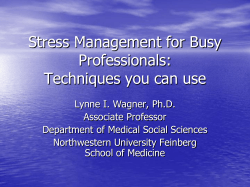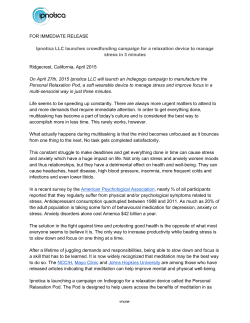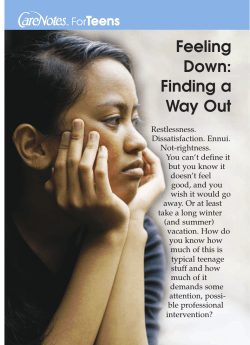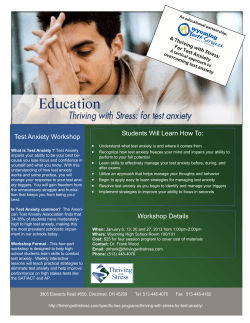
Paper Title (use style: paper title)
The Reduction of Anxiety Level With Benson Relaxationat Cibabat Cimahi Hospital Tetti Solehati, Yeni Rustina Abstract, Client with post cesarean section is sufferring of pain.The pain can cause the anxiety. The anxiety state can be reduced by anxiety management. The anxiety management is not only pharmacological remedy but also non pharmacological treatment. The aim of the study is to identify the reduction of anxiety level with Benson Relaxation Technique among client with post cesarean section. Design of the study was quasi experiment with pre and posttest design. The study was conducted at Cibabat hospital Cimahi. The sample is 30 of post cesarean section women with quota sampling based on criterion. The Benson relaxation technique is mix between relaxation and faith philosophical factor or religion. The focus of this relaxation is at certain world that has a meaning in order to make it calm for the client. This technique is saying several times with regular rhythm of surrender feeling. The Benson relaxation was given along 4 days every 12 hours for 10 minutes. The HARS-Zung modification is used to measure the anxiety. The instrument was applied before and after intervention along 4 days post cesarean section. The result of the study showed that the mean of anxiety before intervention was 16.47. It was decreased to 14,57. The study found the significant comparing of anxiety state before and after intervention (p = 0.00). Thus, the Benson relaxation can reduce anxiety state among client with cesarean section. The researcher recommend for health services institution especially maternity department can use the Benson relaxation technique as a standard operational procedure of nonpharmacologicalanxiety management among client with post cesarean section. Keyword: Benson Relaxation Technique, anxiety, post cesarean section I. INTRODUCTION Surgery is an act that could be threaten the integrity of the person, both bio-psycho-social and spiritual. Surgery procedures can induce pain. Pain experienced by the client surgical may impact to them psychological. Psychological impact often occurs on the client post cesarean section is anxiety. Anxiety is a universal human experience, an emotional response (affective) that are not fun and full of fear, a fear that is not expressed and not targeted as a threat or thought about something that would come up, which is not clear and identifiable, associated with feelings uncertain and helpless [1], [2]. So far, many methods developed to solve the problem of anxiety in clients with post cesarean section with a pharmacological approach and non-pharmacological. One way non-pharmacological suitable for relief levels of anxiety in the client post Caesarean section is relaxation [3]. Relaxation aims to overcome or reduce anxiety, decrease muscle tension and bone, and can indirectly reduce pain and lower the physiological strain associated with the body [4], [6], [7], [8], [2], [3]. In Indonesia, there have been several studies on the effect of relaxation techniques in reducing anxiety with significant results [5], [9]. One relaxation technique is simple, easy implementation, and does not require much cost is Benson relaxation techniques, this relaxation is a combination between relaxation response techniques with individual belief system or faith factor (focused on a particular form of expression of the names of God, or the word has a calming sense to the client itself) repeatedly spoken with a regular rhythm with resignation [10]. Maternity nurses have an important position in helping to meet the needs of clients related post Caesarean section and a sense of savety needs by reducing or eliminateanxiety. The role of nurses are collaborating with other health professionals, as well as interventions to reduce anxiety level, evaluated the effect of interventions, acting as an advocate and educator for clients by teaching them to cope with the anxiety, and training of Benson relaxation techniques. From the preliminary study conducted by researchers in the postpartum Cibabat hospital, it appeared that the room with a capacity of 20 beds was always filled with new clients giving birth, either by caesarean section or pervagina. Whereas the number of nurses in that room was only 16 people, including the head of the room which was divided into 3 shifts, so that nursing interventions especially in non-pharmacological pain reduction as relaxation was never done. A data through client interviews in 5 people post caesarean section was obtained that 4 of 5 people clients experiencing anxiety because of pain from surgery. The pain was on a scale of 6-7 and they ask for pain-killer, 3 of 5 people said that the client was tortured by the pain. 3 of 5 clients ask abaut whether surgical wound can be healed or still long. Three clients said that they was told by the nurses if there is anxiety they should take a deep breathing, but were not given training how it is. These data indicated that the client still has limited information about how to manage anxiety after surgery because of the information do not meet the needs of clients in a comprehensive manner According in this ward has not done research on the effects of relaxation therapy on reducing anxiety levels in clients with post cesarean section and the client still has limited information about how to manage anxiety after surgeryso the researchers were interested in studying the effect of Benson relaxation techniques on anxiety level clients post Caesarean section, considering this technique is relatively easy, does not require a fee, and does not take that much in practice. B. The difference in average of anxietylevel before and after intervention period METHODS The study design used a quasi-experiment by design premises pretest and posttest design. The samples were given the intervention Benson relaxation two hours after the operation, after the effects of anesthesia was lost and conscious clients. Measurements were made over four days: the first day of the two-hour post surgery (before and after intervention Benson relaxation) and the following 12 hours. Then the intervention continued to the second day, third, and fourth after postoperative every 12 hours. Measurement of anxiety was done within for four days every 12 hours. The sample was maternal post caesarean section in the Cibabat hospital totaling of 30 people who met the inclusion criteria (first birth by cesarean section, willing to be responders, using spinal anesthesia, using ketoprofen therapy, awareness compos mentis, never got Benson relaxation exercises yet). Sampling technique was quota sampling. Data collection tool divided into two instruments: (1) instrumentAwas questionnaire concerning demographic characteristics of respondents, and (2) instrument B was using HARS-Zungscale modification questionnaires. Data was collected from April-June 2008. Data was analyzed by univariate, and bivariate (chi square, t test dependent, independent t test) II. RESULT Table 2 Distribution of the average of anxiety level before and after the intervention period in Cibabat hospital (n = 30). Anxietylevel Before intervention After intervention Difference after-before Table 1 above shows that the average of anxiety level before and after the intervention period. In the Benson intervention, the average of anxiety level before being given Benson relaxation was 16.47 down to 14.57 after the intervention period, the difference in pain intensity difference was 1.89. The analysis found a significant differences in average anxietylevelin the intervention group before and after the intervention period (P = 0.00, α = 0.05). III. 1. a. b. A. Respondent characteristic Table 1 Distribution of respondents according to education, employment, and the nature of Caesarean section inCibabat hospital (n = 30) No Variable Σ % 1 2 3 4 5 Age ≤ 35 years > 35 years Parity Primiparity Multiparity Level of education SD (elementary school) SMP (junior high school) SMA (senior high school) PT (undergraduate) Nature Emergency Elective Occupation Have a job Do not have a job 25 5 9 21 83.30 16.70 30.00 70.00 5 10 13 2 20 10 13 17 16.70 33.30 43.30 6.70 66.70 33.30 43.30 56.70 According to Table 1, it showed that the majority of respondents 25 people (83.30%) were aged ≤ 35 years old, the majority of respondents in were multiparity 21 (70%). At level of education, most respondents were SMA 13 people (43.30%). The nature of the majority of Caesarean section was emergency 20 (66.70%). Most respondents do not work as much as 17 (56.70%). For the difference in average of anxietylevel before and after intervention periodcan be seen in Table 2 below. Benson Intervention (n=30) Mean SD P value 16.47 0.98 0.00 14.57 0.58 1.89 0.67 c. d. e. 2. DISCUSSION Respondent Characteristics Age In this study, the majority (83.3) post-Caesarean section maternal age ≤ 35 years old. According Sibuea stated that this age group was safe for the mother to give birth [9], [11], [12], [13]. Education Mother's education level of post Caesarean section in this study the majority (43.30%) was senior high school education. Occupation In this study, the majority (56.7%) mothers did not work. This is consistent with research19 obtained the results of the majority of respondents (51.9%) did not work. Parity Most of the respondents (70%) were multiparity. This contrasts with the results of Sibuea study [11]. This happens because the indications section on research is more due to medical reasons such as maternal multiparity severe pre eclampsia. Nature of Cesarean Section The nature of mother majority of Caesarean Section (66.7%) was the emergency nature. This happens because labor can be avoided by elective Caesarean Section in nature, whereas the nature of the emergency was not. The nature of Cesarean Section due to medical reason cannot be avoidance [14], [15], [16]. Relationship Between Characteristics of Respondents with Clients Anxiety Level Post Caesarean Section. In this study did not find any influence of the characteristics of respondents to the anxiety, both on variables of age, education, occupation, parity, and the nature of Caesarean section. a. Age Age in this study was found that age was not associated with anxiety level. This is in accordance with the study of Anita on the incidence of post-traumatic stress postpartum in women with emergency Caesarean section, vacuum, and spontaneous in the Abdoel Moloek hospital dan Urip Sumoharjo hospital Bandar Lampung, where the research did not find any significant relationship between age and anxiety [17]. These results are supported by research of Karyadi who found that there was no significant difference between age and anxiety (p = 0.840) [18]. b. Education In this study also found that education was not associated with anxiety level. This is in accordance with the study ofAnita where the research did not reveal any significant relationship between education and anxiety (p = 0.22) [17]. Then another study conducted by Amiyanti and Karyadi found that there was no difference between education and anxiety [18], [19]. c. Occupation In this study the result showed that there was not associated among occupationwith anxiety level. The results of this study are consistent with opinion Anita where the research did not reveal any significant relationship between job with anxiety (p = 0.36) [17]. d. Parity In this study did not find any association of parity and cesarean section on the nature of anxiety. This contrasts with the results of Plumb, Orsillo and Luterek who found that the experience was significantly associated with psychological distress [20]. e. Nature of Caesarean Section Judging from the nature of Caesarean Section, in this study did not reveal any significant relationship between the nature of Cesarean Section with anxiety. Yet according to Sibuea study on the client with the elective nature will typically experience anxiety lighter than clients with the nature of the emergency [11], because the client is usually in addition to the elective nature of the planned also been given adequate preoperative information, while the nature of the emergency Caesarean Section often decisions done with a sudden and without adequate preoperative care and without pre-planned. No association between the characteristics of age, education, occupation, parity, and the nature of Caesarean section with anxiety in this study, possibly due to other factors that influence on the anxiety, such as personality development, maturation rate, stimulus characteristics, and individual characteristics [21]. 3. The difference in average anxiety levelof the Respondents. a. The difference in average anxiety level Prior Period Intervention The result showed that the average of anxiety levelimmediately after Caesarean section before the intervention period were included into in a state of mild anxiety (16:47). This contrasts with research Koyama et al., entitled Psychiatric symptoms after hepatic resection that anxiety after surgery were included into the category of being [22]. b. The difference in average anxiety level after Intervention Period The result showed that the average of anxiety levelimmediately after Caesarean section before the intervention period were 14.57. In this study, the results showed that the intervention given to the women post cesarean section effect on anxiety reduction in clients. This can be seen in the results of the bivariate analysis, there were significant differences in mind the average decrease in anxiety after a given intervention Benson relaxation. c. The difference in average anxiety level before and after intervention period. The samples that were given intervention Benson relaxation, anxiety level reduction is resulting from the provision of Benson relaxation intervention. Benson relaxation is a relaxation technique by combining the confidence factor can affect the mother's anxiety post Caesarean Section. It can be seen in the results of the bivariate analysis, where there is a significant difference between the average anxiety in the intervention group were given Benson relaxation before and after the intervention period. This is in line with research conducted by Wallace, Benson and Wilson [10], [24], [25], [26], [27]. IV. CONCLUSION The results found that Benson relaxation techniques proved to be the greatest influence on the decrease in anxiety level. Thus, the researchers suggest, especially the maternity nursing services are expected to use the technique of Benson relaxation as one of the standard operating procedures non pharmacological anxiety management in maternal post Caesarean section, as well as Benson relaxation training can be used as training material for nurses / midwives in the maternity room. As for future research are suggested: sampling techniques in future studies using random sampling techniques so as to better describe the population, need to do further research on practical experience Benson relaxation, as well as similar studies should also be done with the first parity, different tribes, and religious-based hospitals. Results of research conducted in hospitals Cibabat Cimahi conducted on 30 respondents, found that Benson relaxation technique proved to be the greatest influence on the decrease in anxiety level. Thus, the researchers suggestare expected to use the technique of Benson relaxation as one of the standard operating procedures non pharmacological anxiety management in maternal post Caesarean section, as well as Benson relaxation training can be used as training material for nurses / midwives in the maternity room. For nursing education needs to further expand the scope of practice of non-pharmacological management related theory in overcoming anxiety. Nurses always help the client to cope with the anxiety felt by clients with independent and collaborative action. As for further research, sampling techniques in future studies it would be better if you use a random sampling technique that can better describe the population. In future studies should use the medium of film and the addition of the contents of the booklet is complete which is expected to enhance the learning process. Need further research on practical experience in hospital Benson relaxation. In addition, similar studies should be conducted with the first parity constraints, different ethnic and religious-based hospitals. There should also be the development of a standard instrument for measuring the intensity of anxiety variable accordance with the existing culture in Indonesia through a research. REFFERENCES [1] H. I. Kaplan and B. J. Saddock, Synopsis of psychiatry. New york William & Wilkins, 1996. [2] G.W. Stuart and S. J. Sundeen, Principles and practice of psychiatric nursing, St Louis: Mosby, 1998. [3] R. Mander, Nyeri persalinan. Jakarta : EGC, 2004. [4] B. Kozier, G. Erb, and R Oliveri, Fundamental of nursing: Concepts, proces and practice. California :Assison wesleyRedwood city, 1996. [5] U. Sukowati, “Efektifitas paket rileks terhadap rasa nyeri ibu primi para kala I fase aktif di RSUD dr Haryoto Lumajang JawaTimur,” Unpublished, 2007. [6] K. Bally et al, “Effects of Patient-Controlled Music Therapy During Coronary Angiography on Procedural Pain and Anxiety Distress Syndrome,” Critical-Care Nurses. vol. 23, no 2, pp. 50-58, 2003. [7] M..J. Kim, E. S. Nam, and S. I. Paik, “The effects of aromatherapy on pain, depression, and life satisfaction of arthritis patients,” Taehan Kanho Hakhoe Chi, vol. 35, no. 1, pp. 186-94, 2005. [8] M. Beghari et al, “The effect of Benson relaxation technique on rheumatoid arthritis patients: Extended report,” International Journal of Nursing Practice, vol. 12, no. 4, pp. 214-219, 2006. [9] Anggorowati, “Efektifitas pemberian intervensi spiritual paket spirit terhadap nyeri post section caesarean (SC) pada RS sultan agung dan RS Rumani semarang,” Unpublished, 2006. [10] H. Benson and W.. Proctor, Dasar–dasar respon relaksasi. Edisi 1, Alihur hasan, Bandung: Penerbit Kaifa, 2000. [11] D. H. Sibuea, Manajemen seksio sesarea emergensi; masalah dan tantangan, Medan: Gelanggang Mahasiswa USU, 2007. [12] D. Setyorini, “Efektifitas pemberian paket ibu terhadap kecemasan ibu dengan seksio elektif di Surabaya,“. Unpublished, 2006. [13] H. K. Gondo, “Fenomena social operasi seksio seasarea di salah satu RS swasta besar Surabaya periode 1 Januari 2000-31 Desember 2005,” Dexa Media, vol. 02, no. 19, pp. 72-78, 2006. [14] S. Mc.Aleese, “Caesarean section for maternal choice” Assosciation of Medical Midwifery, Issue no 84, 2004. [15] L. N. Sherwen, M. A. Scoloveno, and C.T. Weingarten, Maternity nursing: Care of the childbearing family.3rd ed., USA: Appleton &Lange, 1999. [16] T. Duffet, and Smith. Persalinan dengan bedah Caesar, Edisi 2, Jakarta : Arcan, 1992. [17] Anita. “Kejadian stress pasca traumatic pada ibu post partum dengan seksio sesarea emergensi, vacuum, dan spontan di RS Abdoel Moloek dan RS Urip Sumoharjo Bandar Lampung,” Unpublished, 2006. [18] Karyadi, “Hubungan antara gaya kepemimpinan kepala ruangan dengan tingkat stress perawat pelaksana di ruang rawat inap Rumah Sakit Tugu Ibu Depok,” Unpublished, 2004. [19] L. Amiyanti, “Analisis faktor-faktor yang berhubungan dengan terjadinya stress kerja pada perawat pelaksana di instansi gawat darurat RSUPN DR Cipto Mangunkusumo Jakarta,” Unpublished, 2001. [20] J.C. Plumb, S. M. Orsillo, and J. A. Luterek, “A preliminary test of the role of experiential avoidance in post-event functioning,” Journal of Behavior Therapy and Experimental Psychiatry, vol. 35, no. 3, pp. 245-257, 2004. [21] Direktorat Kesehatan Jiwa RI, Perawatan pasien yang merupakan kasus-kasus psykiatri, Jakarta, 1994. [22] K. Koyama et al, “Psychiatric Symptoms After Hepatic Resection,” The Academy of Psychosomatic Medicine, vol. 44, pp. 86-87, 2003. [23] A. Khanna, M. Paul, and J. S. Sandhu, “Efficacy of two relaxation techniques in reducing pulse rate among highly stressed females,” Calcut Medical Journal, 2007. [24] A. Baskoro, Menggapai hening, memetik sehat. ¶ 1.http://profiles.blogdrive.com, cited in 4 Juni 2008. [25] R. F. Levin, G. B. Malloy, and R. B. Hyman, “Nursing management of postoperative pain: use of relaxation techniques with female cholecystectomy patients,” Journal of Advanced Nursing, vol. 12, no. 4, pp. 463–472, 1987. [26] K. M. Dendato and D. Diener, “Effectiveness of cognitive/ relaxation therapy and study-skills training in reducing selfreported anxiety and improving the academic performance of test-anxious students,” Journal of Counseling Psychology, vol. 33, no. 2, pp. 131-135, 1996. [27] D. Fenlon, “Relaxation therapy as an intervention for hot flushes in women with breast cancer,” European Journal of Oncology Nursing, vol. 3, no. , pp. 223-231, 1999. Tetti Solehati is a lecturer, researcher, and community service at Padjadjaran University Bandung Indonesia. She was born on Mei 27th 1973 in Bandung Indonesia. She got BSN at Padjadjaran University in 2000 and Master of Nursing at Indonesia University in 2008. Her major is maternity nursing and she teaches maternity nursing and reproductive system. Several researches have been done since 2008. It related to pain management of Benson relaxation, cesarean section, and pregnancy. He was also a speaker at various seminars and conferences. She had got a research grand from Padjadjaran University and Indonesian Nurses Association.
© Copyright 2025









